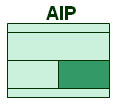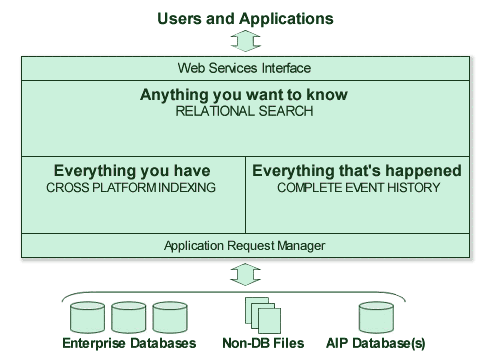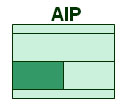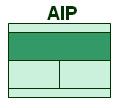PointofData's Active Information PlatformTM
PointofData's Active Information Platform uses pattern search to find valuable information that resides in existing data and event records, and then provides the platform for adding any type of new information on demand, all without changing the original data..
Everything a company has: Data
The Active Information Platform indexes structured and unstructured data, supporting virtually any file format. Since information typically resides in various databases, business applications or legacy applications, the Active Information Platform has been designed to incorporate data from all of these sources. The Active Information Platform's unlimited scalability ensures that all data within any organization will be integrated, even as data sets continue to grow. PointofData's patent pending Dynamic Indexing
TM makes this possible; using Dynamic Indexing, indexes for searches are a fraction of the original data's size, and the size of the index as a percentage of the original data size may actually shrink as entries are added. As more data is added, the Active Information Platform scales without impacting system performance.
By contrast, companies face significant constraints with current database technologies: disparate systems cannot be accessed from a single location; as information is added to the database its performance degrades; and new data requirements can be highly difficult to add and store. These limitations prevent companies from responding to their competitive needs.
Everything a company has done: Event records

Accelerating current analyst's predictions by at least five years (Gartner recently predicted that event driven architectures would not become mainstream until 5-10 years), PointofData is the first company to introduce an integrated event driven architecture. The Active Information Platform's Event Driven Architecture allows applications to work together to satisfy information retrieval requests or business process requirements and it is the only system capable of collecting event records for entire companies. Event records have several features; they can include when, where, by who and how data is accessed. Every time data is changed, an event record logs this change, creating a geometric growth in data collection needs. The Active Information Platform's Event Driven Architecture allows companies to add annotations and new fields without changing any of their existing data (see diagram) and without the traditional storage overhead. Finally, the Active Information Platform's performance scalability and efficient indices ensure high performance retrieval, even when a massive amount of data is collected.

By contrast, current database technologies have trouble processing event logs because of their size and complexity. As data is updated, the previous data is removed, so companies are unable to compare changes over time. Additionally, it may be impossible to add new annotations or event fields due to table complexity.
Anything a company wants to know: Desired information
Storing data and event records is the first step--searching them is the second. The Active Information Platform allows companies to perform n-dimensional and multi-tiered searches in order to identify important patterns or relationships within their data and event records. N-dimensional searches support unlimited parameters. Searches can use any criteria, span ranges and combine fields. Multiple-tiered searches, or "searches within a search," offer a way to target desired information without having to start a new search each time.
Additionally, the Active Information Platform is a temporally aware system that allows companies to compare their past and present data and event records. The Active Information Platform provides new views of corporate infrastructures over time, so companies can compare any point in time to now.
By contrast, companies using current search technologies cannot search across diverse databases, data silos, business applications or legacy applications using a single query language. They have to query the systems individually using specialized queries. Without event records and a temporally aware system, they cannot review changes that take place over time. Additionally, current search technologies only look for text with limited Boolean searches. This limits the user, who is unable to search for information that would be found using the AIP's pattern matching.






